
Portsmouth, Southsea and Isle of Wight Aviation - Guildhall Label
The company was first formed in 1928 at Maylands Airport in Essex but was unable to renew their lease and moved to the
Isle of Wight to become Wight Aviation. as a joy riding and charter company. It was taken over in early 1932 and on May
11th, 1932 changed its name to Portsmouth, Southsea and Isle of Wight Aviation. The main driver was Lionel Balfour who
invested £5000 of his own money in the enterprise as well as getting outside backers. The owners had bought a farm near
Ryde in March and it became Ryde Airport where services began on the 27th June to Portsmouth. In 1934 it thought it
would get a contract to fly mail to the Isle of Wight but despite the companies’ fine record this did not happen. They flew 5
experimental flights in 1934 and 1935 and produced two air stamps/labels. Using tactics that would be illegal today
(threatening to withdraw agencies for railway tickets, if the Agents sold tickets for PSIOWA), the railways forced the closure
of the London route. Although they never got a mail contract the company were successful with their passenger services.
Despite this it was never financially secure, a situation it held in common with many independent airlines of that time. At its
peak in summertime the company was flying 30 journeys each way a day and carrying thousands of passengers. It carried
on in existence until 1947 when the nationalizations occurred and then became an aero engineering and design company
which is still in existence today. Redgrove’s dismissal of anything to do with covers and stamps after the first flight is not a
view held today and all the covers the company flew are in demand when they appear on the market. I would like to thank
Mark Le Breton of the British Airmail Society for his help in providing many of the images in this section and much of the
more intelligent text.
Portsmouth, Southsea and Isle of Wight Aviation. The Guildhall Air Label
In February 1934, a special blue stamp for the ‘Air Ferry Service’ was prepared in two printings and an experimental return mail flight made between Portsmouth and Ryde on 3rd February. The company hoped to run an airmail service in the Summer and to issue a series of stamps depicting scenes in the Isle of Wight and South Coast. There were two printings of the first stamp. The first print run consisted of 4000 stamps in 200 booklets. The print run consisted of 4000 stamps in 200 booklets, which should have been numbered 1-4000, but in fact were numbered 1-3980. This is because the 200th booklet was found to be unnumbered. Additionally, booklet 16, numbers 301-320, was found to be imperforate. Both errors were blamed on a lack of attention to detail on the part of the printer’s assistant.Artist Mock-,up and Postcard
Below are the artist mock-up of the Air Label and a postcard which is believed the artist used to draw the Guildhall label. There is no provenance with this postcard and although it is always possible that the pencil markings were done later, there are good reasons for thinking this is genuine. Firstly, all the items in the postcard that have been crossed out do not appear in the mock-up. Secondly, the artist has included the buildings on the left of the Guildhall and the bushes on the right of the postcard in the mock-up. These do not appear in the final label. This makes it likely this postcard was used to aid the artist in his drawing.
Copyright
© 2022 Robert Farquharson All Rights Reserved

British Internal Airmails of the 1930’s



Guildhall label colour trials
1st Printing
4000 labels were printed in the first print run and stapled into booklets of 20 stamps. The stamps were printed in groups of four onto pre-gummed paper. The perforation was done after the printing so the sides of the stamps in the booklet are imperforate. After printing the stamps were numbered consecutively in red. They should have gone from 1 - 4000 but the printers assistant was careless and the last booklet which should have been 3891 - 4000 was left unnumbered. It wasn’t his day as he also left booklet 16 with the number 301 - 320 unperforated.
These are the five colours on offer. The directors chose the blue stamp on the top left. I would have chosen the green. The printers details are
printed on the back of the trial printings, these are shown bottom right.
Proofs
The proofs were printed in blocks of sixteen and split into groups of eight. Perforate and imperforate are illustrated below.
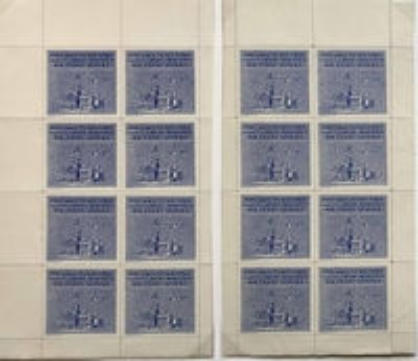

The final proof was in sixteen in two groups of eight. It was on ppink backing card which is illustrated below.
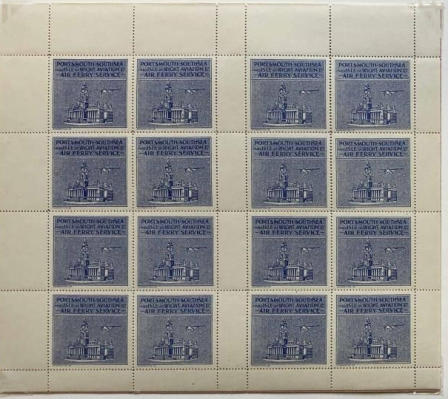
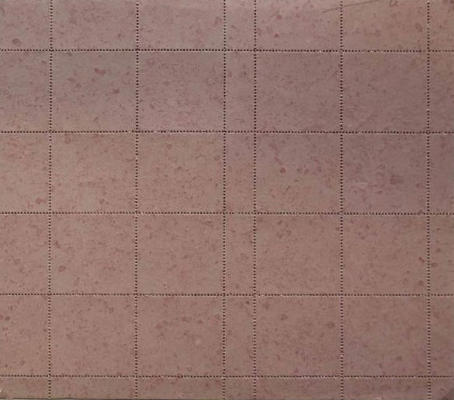

On the top left is a pane from the booklet which
is imperforate. Above is a pane from the lasst
booklet of the printing which was left
unumbered. On the left is a normal pane from
a booklet.
Second Printing
The perforating on the the first printing was consdered unsatisfactory so changes were made for the second printing. Four blocks of four were printed on gummed paper and laid over a peice of thick pink card. This resulted in perforations extending to the margins and stamps perforated on all sides. 201 booklets were made up as before with twenty in each booklets in panes of four. They were numbered 3981 - 8000. After printing the plate was defaced and four proof sheets, two imperforate and two perforate were retained as a record.
Proof block of four pre-pink card.

Imperforate final proof sheet of 16

2nd Printing booklet pane

Portsmouth, Southsea and Isle of Wight Aviation - Guildhall Label
The company was first formed in 1928 at Maylands Airport in Essex but was unable to renew their lease and moved to the Isle of Wight to become
Wight Aviation. as a joy riding and charter company. It was taken over in early 1932 and on May 11th, 1932 changed its name to Portsmouth,
Southsea and Isle of Wight Aviation. The main driver was Lionel Balfour who invested £5000 of his own money in the enterprise as well as getting
outside backers. The owners had bought a farm near Ryde in March and it became Ryde Airport where services began on the 27th June to
Portsmouth. In 1934 it thought it would get a contract to fly mail to the Isle of Wight but despite the companies’ fine record this did not happen. They
flew 5 experimental flights in 1934 and 1935 and produced two air stamps/labels. Using tactics that would be illegal today (threatening to withdraw
agencies for railway tickets, if the Agents sold tickets for PSIOWA), the railways forced the closure of the London route. Although they never got a mail
contract the company were successful with their passenger services. Despite this it was never financially secure, a situation it held in common with
many independent airlines of that time. At its peak in summertime the company was flying 30 journeys each way a day and carrying thousands of
passengers. It carried on in existence until 1947 when the nationalizations occurred and then became an aero engineering and design company
which is still in existence today. Redgrove’s dismissal of anything to do with covers and stamps after the first flight is not a view held today and all the
covers the company flew are in demand when they appear on the market. I would like to thank Mark Le Breton of the British Airmail Society for his
help in providing many of the images in this section and much of the more intelligent text.
Portsmouth, Southsea and Isle of Wight Aviation. The Guildhall Air Label
In February 1934, a special blue stamp for the ‘Air Ferry Service’ was prepared in two printings and an experimental return mail flight made between Portsmouth and Ryde on 3rd February. The company hoped to run an airmail service in the Summer and to issue a series of stamps depicting scenes in the Isle of Wight and South Coast. There were two printings of the first stamp. The first print run consisted of 4000 stamps in 200 booklets. The print run consisted of 4000 stamps in 200 booklets, which should have been numbered 1-4000, but in fact were numbered 1-3980. This is because the 200th booklet was found to be unnumbered. Additionally, booklet 16, numbers 301-320, was found to be imperforate. Both errors were blamed on a lack of attention to detail on the part of the printer’s assistant.Artist Mock-,up and Postcard
Below are the artist mock-up of the Air Label and a postcard which is believed the artist used to draw the Guildhall label. There is no provenance with this postcard and although it is always possible that the pencil markings were done later, there are good reasons for thinking this is genuine. Firstly, all the items in the postcard that have been crossed out do not appear in the mock-up. Secondly, the artist has included the buildings on the left of the Guildhall and the bushes on the right of the postcard in the mock-up. These do not appear in the final label. This makes it likely this postcard was used to aid the artist in his drawing.Sunshine Express Flight to Bournemouth and Shoreham. 17 May 1934.
The second printing of the stamps consisted of 201 booklets numbered 3981-8000 The company hoped to make an extra charge of 3d, although no
price was on the stamp. On the 17th May 1934, C.R. Crow, of the Portsmouth, Southsea and isle of Wight Aviation, Ltd., made the first flight of ‘The
Sunshine Air Express’ from the Portsmouth City Airport to Shoreham and Bournemouth. This was the first day of the regular summer passenger
service. He left Portsmouth City Airport at 9.35 a.m. and arrived at Shoreham at 10 a.m. He carried twenty letters on this flight which were posted at
Shoreham on arrival. The machine returned to Portsmouth at 10.10 a.m. and then left for Bournemouth, arriving at 11 a.m. Twenty letters were also
carried on this flight and posted at Bournemouth on arrival. All the covers are signed ‘C.R. Crow, Pilot’ and mostly carry second printing stamps.
The ‘Island Express’ Label
In a letter to the AIrpost Journal signed ‘A director of PSOIWA’ (probably Lionel Balfour or Francis Luxmoore) the company position was thus stated. “As you are aware, we originally issued a vignette, one showing the Portsmouth Guildhall, which was intended for our Air Ferry Service from Ryde to Portsmouth, and to Bournemouth and Shoreham. Except for a few experimental flights, these were all disposed of to collectors and dealers, and the blocks destroyed. When it was announced that the Postmaster-General intended to open the inland air services, we fully expected to be included in the first flights, especially in view of our regular daily passenger services, and also to the fact that Portsmouth Airport possesses the finest landing ground in Europe. We were of opinion that air mail would have been carried from London to the Isle of Wight, and as the proof sketch was already in existence, and we expected to be allowed to make a charge, we decided to proceed with the printing of these, so that we might be ready at short notice. The idea was to use sepia for the journey up to London, and blue for the return to the Island. We were surprised when the Postmaster-General announced that contracts would be given to a few places to run at ordinary postage rates, and we were not included. We are, however, in negotiation with the Authorities, and there is very little doubt that we shall be included in the next batch. As we do not anticipate being allowed to make a charge, we hope to use up our stock on first flight souvenir envelopes. At present, no general use has been made of these, except a few covers on experimental flights sent to private addresses. These were posted at the Post Office on the arrival of the ‘plane. As before, the labels were printed by Messrs. Charpentier Ltd. of Portsmouth, 250 booklets of each colour being issued.”Third flight. Ryde to London (Heston) 02 August 1934.
On the 2nd August 1934, Flight Lieutenant A.E. Rogenhagen left Ryde, Isle of Wight, Airport at 6.20 p.m. and arrived at Heston at 6.50 p.m. He carried twenty letters which were posted on arrival. This was the first use of ‘Island Air Express’ labels showing a plane flying over the Needles. On the return journey the machine left Heston at 7.10 p.m. and arrived at Ryde at 7.45 p.m. with blue stamps and posted at Ryde on arrival. As the Company did not have a date stamp for Heston the covers were stamped on arrival with the Ryde Airport date stamp of the same date. Because the covers were posted at Ryde late in the evening in a pillar box out of the town they were not collected until the following morning and therefore they bear the Ryde postmark of August 3rd. The twenty covers to Heston and twenty to Ryde were the only covers carried on this first experimental flight and all are signed ‘Flight Lieutenant A.E. Rogenhagen, Pilot’.Fourth flight. Ryde to Portsmouth. 07 December 1934.
On 7th December, a special flight was made from Ryde to Portsmouth bearing mails for local addresses but also some made up for the first scheduled flight to Australia the following day with addressees in both Australia and New Zealand. Additionally, it appears that some mails were made up purely as souvenirs, being unaddressed and not used postally. The pilot was Flt. Lt. A E Rogenhagen. All envelopes bear the Company ‘Ryde’ cancellation dated the 7th. Those bound for local addresses are cancelled with a single-ring 10AM Portsmouth & Southsea GPO cancel, whereas those destined for the Australia flight bear a 6.15PM double-ring Portsmouth & Southsea GPO cancel. Two types of mail are known for the latter flight; the first is the numbered official England-Australia Air Service envelope, the second is a twice-folded ‘Air Ministry’ leaflet giving details of the service. Both types were prepared by B J Tay of Portsmouth and bear his printed details on the backs in green ink. Tay wrote in ‘Aero Philatelic Club (London). Notes of the Month. January 1935’. “At 9. 10 a.m. on the 7th. December 1934, Flight Lieutenant A. E. Rogenhagen in a Fox Moth plane bearing the registration letters G.A.C.I.G. left Ryde Airport for the Portsmouth City Airport. He carried twenty-one letters in special Imperial Airways envelopes for the first regular air mail for Australia and New Zealand, together with six copies of the Air Ministry Government White Paper. In addition to the postage, the covers and White Papers bore "The Needles" Air Label of the Company, and the Ryde Airport date stamp of the same day. The plane arrived at the Portsmouth Airport in a rainstorm. Twelve letters addressed to various persons in Portsmouth were carried at, the same time and these bore the date stamp of the Ryde Airport and the special "Needles” Air Label of the company together with the postage, and were posted at the Portsmouth G.P. O. at 10 a.m. that day and the postmark is to this effect. Two imperforated labels in sepia and two in blue were used on the covers to New Zealand and Portsmouth and these came from booklets.”
The souvenir covers have a type-written explanation, the Company cancel, and a purple cachet ‘PORTSMOUTH/BY AIR/7 DEC 34’ which is not seen on any
other envelopes. Covers exist with both colours of vignette, in vertical pairs. They are signed by the pilot A. E. Rotenhagen. Very little is known of these
covers and their origin. The number of these flown is not known, but it is likely even by PSIOWA standards to be small.
Twenty one covers were made up for the first scheduled flight to Australia the following day with addressees in both Australia and New Zealand.
Fifth flight. Portsmouth to Shanklin. 07 May 1935.
This was the first day of the issue of the King’s Jubilee stamps and Flying Officer W. J. Scott, made the first mail carrying flight from the Portsmouth City Airport to Shanklin, Isle of Wight, carrying twenty letters bearing the special stamp of the Company and the new Jubilee stamps. These were addressed to various persons in Portsmouth. The envelopes were serially numbered on the back 1 to 20. Those numbered 1 to 10 bore blue air express stamps while those numbered 11 to 20 bore the sepia stamps, and the Portsmouth City Airport date stamp of the same day. Each envelope is signed by the pilot. The return flight was made the same day and piloted by Flying Officer R.C. Ellison. It left Shanklin at 10.15 a.m. and arrived at the Portsmouth City Airport at 10.25 a.m. Each envelope is signed by the pilot.
Copyright
© 2020 Robert Farquharson All Rights Reserved
First Experimental Flight 03rd February 1934
20 covers were sent in both directions on this first flight all signed by the pilot A. Whitta. The Post Office invoked their monopoly, and no further airmail service took place.Newspaper Labels
Redgrove notes that on a number of occasions Portmouth, Southsea and Isle of Wight Aviation flew newspapers to the Isle of Wight. These had a green aeroplane cachet at the top of the paper. The following example was flown on June 30 1936.
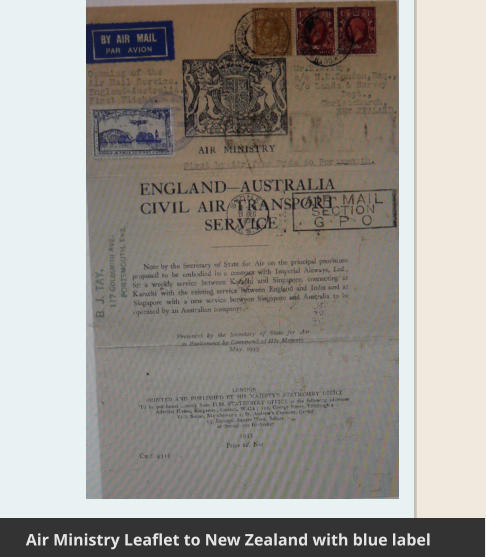
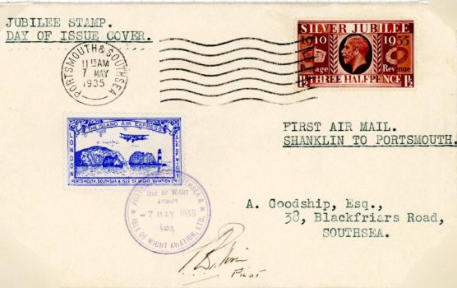
7th May 1935 Shanklin to Portsmouth.
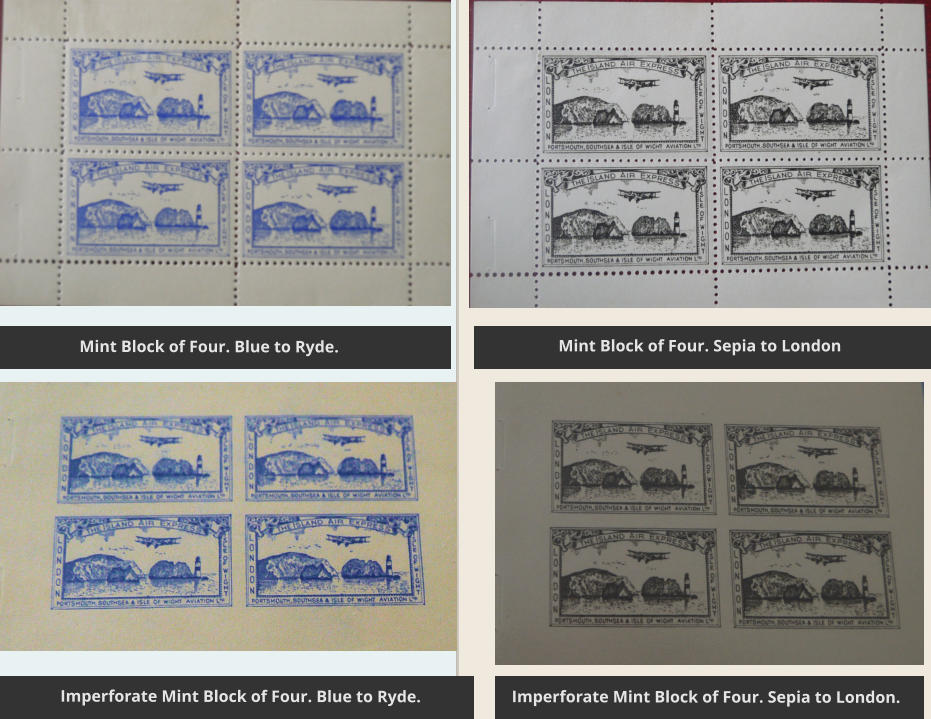

British Internal Airmails of the 1930’s
Most stamps came out of booklets where there 5 panes of 4 stamps. The stamps out of booklets can be identified by two tiny little holes down the left
hand side. Occasionally there are no holes as shown below and these are probably final proofs.


Souvenir Sepia

7th May 1935 Portsmouth to Shanklin

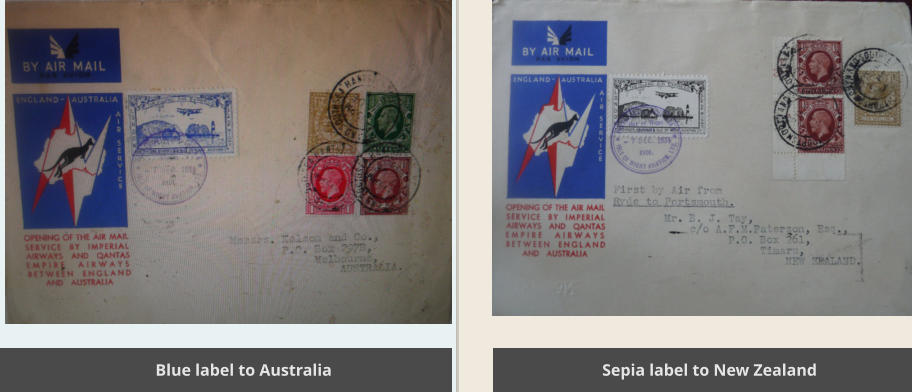

Heston to Ryde 02 Aug 1934
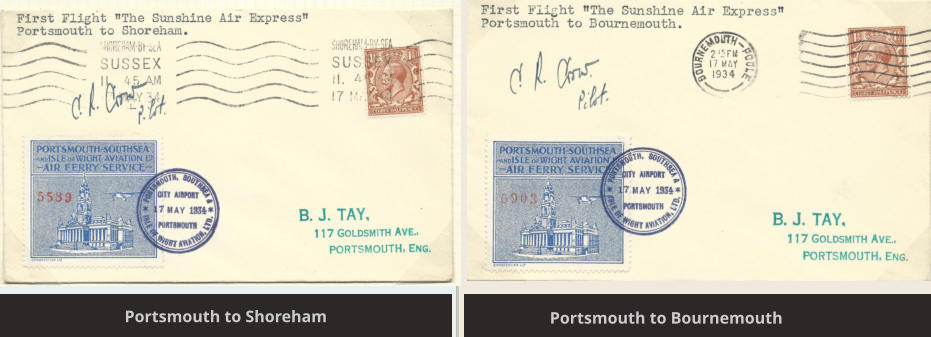








Artist Mock-up of Guildhall
Postcard of Guildhall probably used by Artist
Guildhall label colour trials


Mint Block of Four. Blue to Ryde.
Imperforate Mint Block of Four. Blue to Ryde.


Sepia posted locally
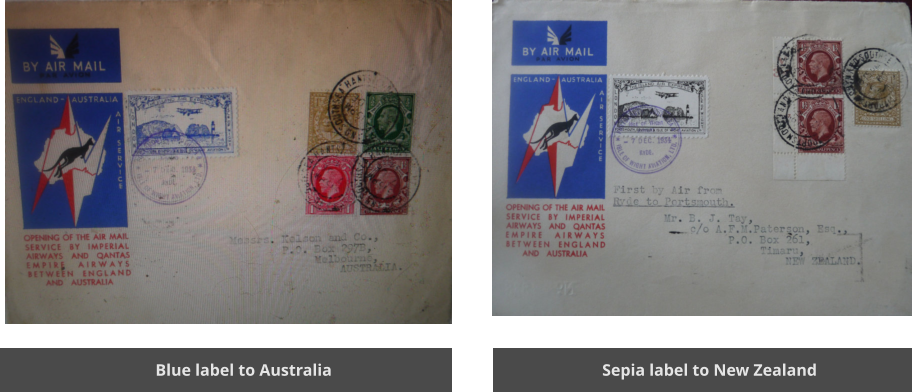
Blue label to Australia


Air Ministry Leaflet to New Zealand with blue label
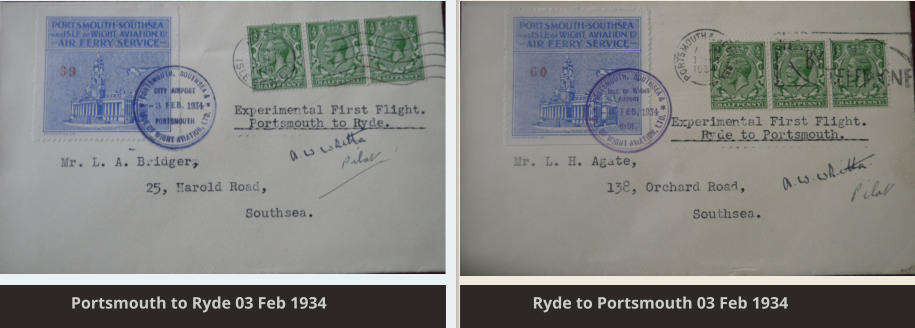
Air mail labels on covers other than PSIOWA flights
The vast majority of Air mail labels were used on PSIOWA flights, although a couple of covers on non PSIOWA flights have been recorded. The first example was sent by our old friend A. Phillips of Newport. It was sent on the 5th March and postmarked Newport and sent to Phillips address in Newport. It had a second printing ‘Town Hall’ label. Perhaps he meant to sell it as a genuine cover, who knows. There are a few examples of the Phillips covers and it is not known how many were sent. Some examples seen have been expensive to buy, but be clear they have no connection with the airline and were not flown. The second example is a postcard sent to USA on the 29th June 1939 with a sepia ‘Needles’ label after the last PSIOWA flight. The history of this card is not known.
Phillip cover sent locally on 5th March 1934



































